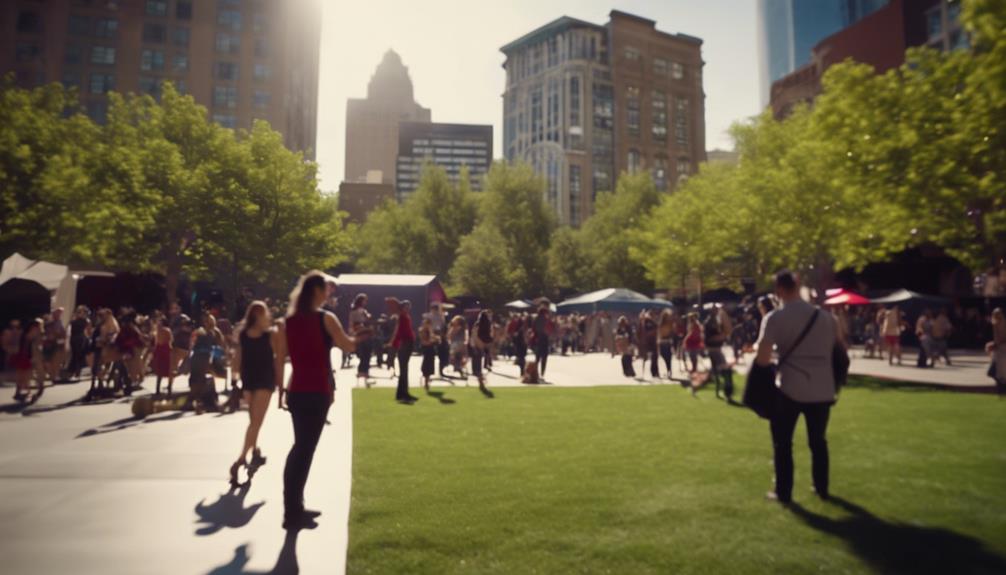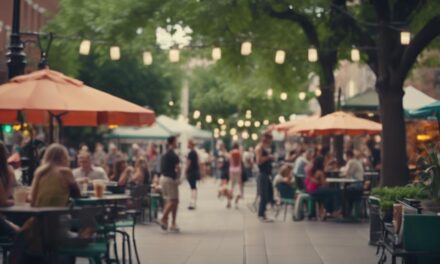You've probably noticed how downtown public spaces always seem to buzz with energy and activity. Ever wondered why? It's not just the green spaces and parks that draw people in, but a mix of thoughtful design and vibrant events that cater to everyone. Pedestrian-friendly layouts, local markets, and striking public art all play a role. Then there's the sense of community, the opportunities for social interaction, and the economic boost to local businesses. So, what ties all these elements together to make these spaces so dynamic? Let's explore further and uncover the secrets behind their vibrancy.
Key Takeaways
- Green spaces and parks offer relaxation and socialization, enhancing urban livability.
- Pedestrian-friendly designs prioritize safety and encourage foot traffic with amenities like wide sidewalks and public art.
- Regular events and markets attract diverse crowds and support the local economy.
- Public art installations reflect local identity and create engaging landmarks.
- Recreational opportunities and social interaction hubs foster community engagement and vibrancy.
Green Spaces and Parks
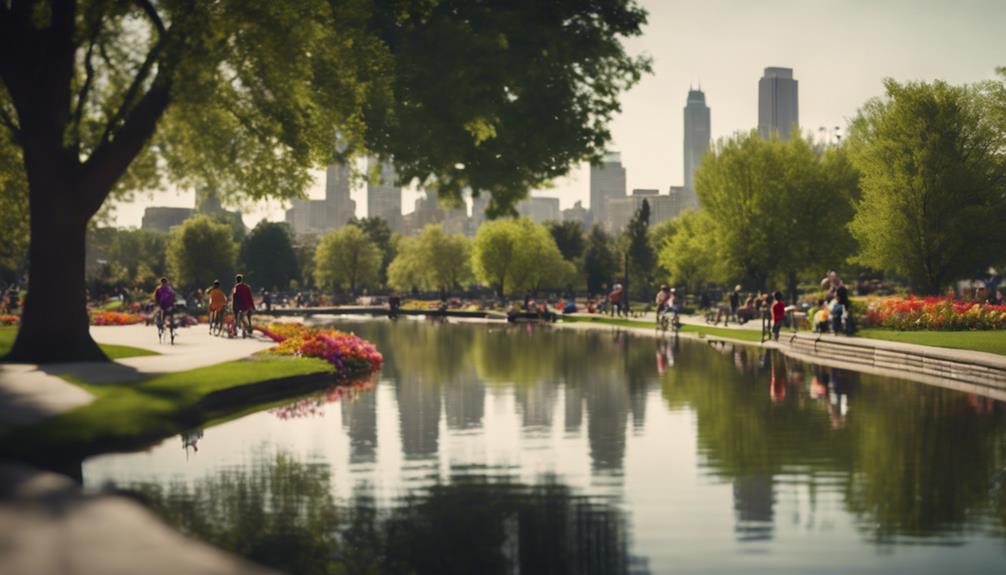
Green spaces and parks in downtown areas serve as essential urban oases, enhancing both livability and the overall vibrancy of the community. You'll find that these green spaces offer much-needed breathing room amidst the dense urban landscape, providing both residents and visitors with areas to relax, exercise, and socialize.
Take Millennium Park in Chicago, for instance. This urban park isn't just a patch of greenery; it's a magnet for millions of visitors annually, illustrating how such spaces can greatly boost the vitality of downtown areas.
Central Park in New York City is another prime example. Spanning over 840 acres, it offers a substantial retreat from the hustle and bustle of city life. This vast green space not only provides a peaceful escape but also serves as a venue for numerous activities and events, further enhancing its appeal.
Similarly, Klyde Warren Park in Dallas exemplifies how urban parks can function as dynamic community hubs. Hosting everything from yoga classes to food truck festivals, it attracts a diverse audience, fostering a sense of community and belonging. These events aren't just recreational; they're strategic in drawing varied demographics to the downtown area, thereby enhancing its vibrancy.
In Atlanta, Piedmont Park serves as a cultural hotspot. By hosting concerts, art festivals, and recreational activities year-round, this urban park becomes an essential part of the city's cultural fabric. Such green spaces do more than offer aesthetic value; they strategically contribute to the social and economic dynamism of downtown areas, making them indispensable for urban planning and development.
Pedestrian-Friendly Design
While green spaces and parks offer natural retreats, pedestrian-friendly design transforms urban landscapes into walkable, vibrant hubs that invite exploration and social interaction. By incorporating wide sidewalks, seating areas, and green spaces, downtown public spaces become more accessible and engaging. These elements create an environment where people feel encouraged to walk, linger, and engage with their surroundings.
To achieve a successful pedestrian-friendly design, it's important to prioritize pedestrian safety. Well-maintained crosswalks, well-lit pathways, and traffic calming measures reduce accidents and make walking a more appealing option. Wide sidewalks provide ample space for pedestrians, reducing congestion and enhancing the overall experience. These sidewalks often feature street furniture, such as benches and public art installations, which invite people to rest and appreciate their environment.
Seating areas strategically placed throughout the downtown area offer spots for relaxation and socialization, further encouraging people to spend more time outdoors. Incorporating green spaces within these urban settings not only adds aesthetic value but also provides a revitalizing break from the concrete jungle. These green spaces serve as natural gathering points, fostering community interactions and enhancing the vibrancy of downtown areas.
Wayfinding signage is another important component of pedestrian-friendly design. Clear, informative signs help people navigate the area efficiently, making the entire space feel more user-friendly. This attention to detail ensures that even newcomers can comfortably explore and appreciate the downtown offerings.
Ultimately, a well-designed pedestrian-friendly area attracts more foot traffic, boosting economic activity and community vitality. By creating inviting environments, you encourage people to explore, linger, and participate, making downtown public spaces truly vibrant and dynamic hubs.
Events and Markets
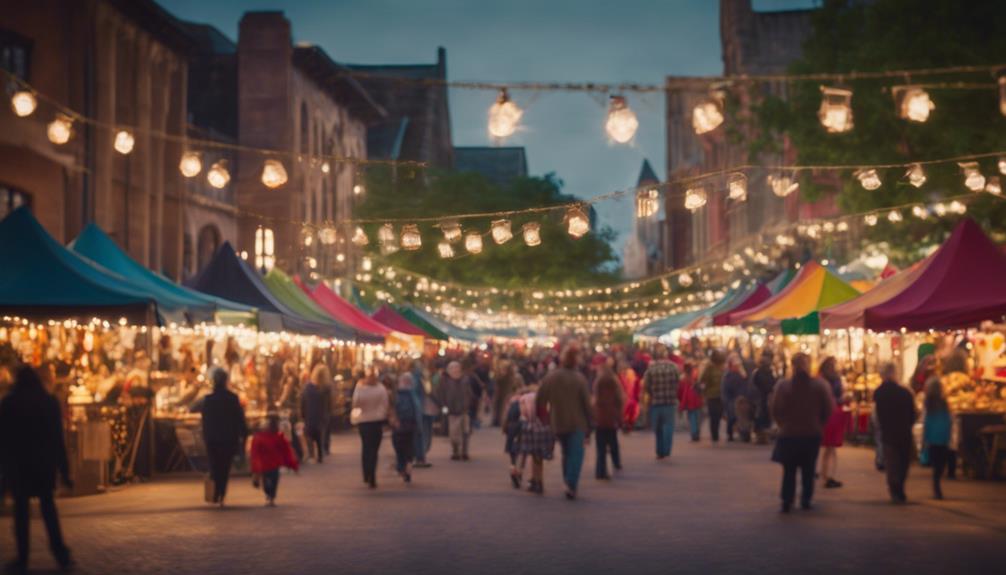
A diverse array of events and markets transforms downtown public spaces into vibrant, dynamic hubs that foster community engagement and economic vitality. When you explore these areas, you'll find that events like concerts, art exhibitions, and cultural festivals attract diverse audiences, creating a melting pot of experiences and interactions. These events not only entertain but also provide opportunities for cultural exchange, making downtown spaces lively and inclusive.
Strategically, markets such as farmers' markets and artisan fairs play a significant role in animating downtown public spaces. They offer unique shopping experiences that can't be replicated by traditional retail stores. By supporting local businesses and artisans, these markets contribute to the local economy and provide visitors with a sense of community and place. You'll notice how these markets often become regular social gatherings, where people not only shop but also connect with one another.
Events like food truck gatherings and pop-up shops add another layer of excitement and dynamism. These temporary setups draw in crowds and create a lively atmosphere, often becoming the talk of the town. They cater to a wide range of tastes and preferences, ensuring that there's something for everyone.
Additionally, street performers and live music enhance the vibrancy of these spaces, offering spontaneous entertainment and engagement. Seasonal events, holiday markets, and community celebrations further enrich the urban environment by bringing people together. These gatherings create a sense of belonging and shared experience that's essential for a vibrant downtown.
Public Art Installations
When you explore public art installations in downtown spaces, you'll notice how they serve as engaging visual elements that capture attention and spark curiosity.
These installations also act as a canvas for community cultural expression, reflecting local identity and values.
Additionally, interactive art spaces invite public engagement, transforming mere observation into participatory experiences.
Engaging Visual Elements
Public art installations transform downtown public spaces into vibrant cultural hubs, drawing in visitors and fostering a sense of community. These installations play an essential role in creating a vibrant atmosphere in downtown areas by incorporating engaging visual elements.
When you walk through downtown, you're likely to encounter vibrant murals, striking sculptures, and interactive art pieces that catch your eye and invite you to explore further.
Strategically placed public art installations serve multiple purposes. They not only beautify the space but also act as landmarks and meeting points, making it easier for residents and tourists alike to navigate the area. The visual appeal of these installations often reflects the cultural identity of the community, showcasing local artists' talents and adding a unique flavor to the downtown environment.
Moreover, engaging visual elements like street art and art festivals are essential in maintaining the vibrancy and uniqueness of downtown public spaces. These elements captivate the public and encourage social interaction, making the area more lively and engaging.
Community Cultural Expression
Through the strategic placement of public art installations, downtown areas can vividly express their community's cultural identity and values. These installations serve as visual landmarks, attracting both residents and visitors. They come in various forms, from sculptures and murals to interactive multimedia displays, each contributing to a richer, more vibrant downtown public space.
Public art installations often reflect local history, values, and stories, fostering a deeper sense of pride and belonging among community members. For example, a mural depicting the town's founding moments or a sculpture honoring local heroes can become focal points that resonate with the community's collective memory. This cultural expression not only strengthens community bonds but also enhances the downtown area's attractiveness.
Moreover, the diversity in artistic expressions showcased through public art installations enriches the overall vibrancy of downtown public spaces. By incorporating different artistic mediums and styles, these installations appeal to a broad audience, ensuring that everyone finds something meaningful. Strategically placed, they create a dynamic environment that invites exploration and engagement, reinforcing the downtown area's role as a cultural hub.
In essence, public art installations are indispensable in making downtown public spaces vibrant and culturally expressive.
Interactive Art Spaces
Building on the cultural vibrancy established by public art installations, interactive art spaces take it a step further by actively engaging visitors in the creative process. In downtown public areas, these spaces offer hands-on participation, inviting people to become part of the art itself. This involvement transforms passive observation into an immersive experience, making the public area more dynamic and engaging.
Interactive art spaces often reflect the cultural identity of the city, serving as both landmarks and mirrors of local heritage. For example, a light display that changes colors based on public input can symbolize the city's diversity and inclusivity. Such installations not only draw tourists but also foster a sense of pride among residents.
Moreover, these interactive elements encourage social interaction, turning strangers into collaborators and friends. By participating in a communal art project, visitors connect on a deeper level, fostering a stronger sense of community and creativity.
The dynamic nature of these spaces attracts a diverse audience, from art enthusiasts to casual strollers, enhancing the overall vibrancy and appeal of downtown public areas.
Social Interaction Hubs
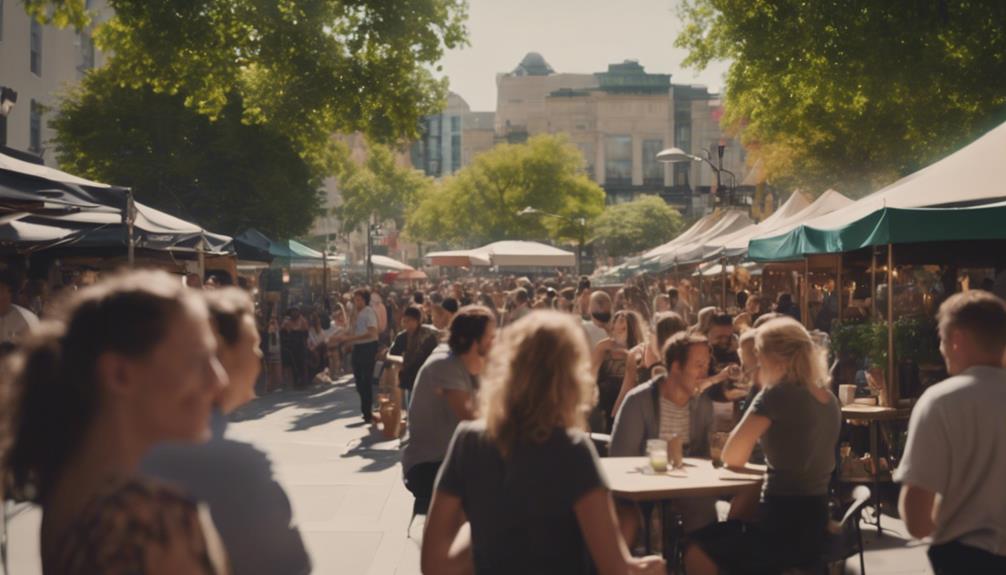
In downtown public spaces, vibrant social interaction hubs act as catalysts for community engagement and cultural exchange. These bustling areas attract diverse groups, providing platforms for lively cultural activities and fostering a sense of belonging and pride within the community. The strategic design of these hubs guarantees they're accessible and appealing to both residents and tourists, creating a lively atmosphere that promotes social exchange.
Key elements that make these social interaction hubs so effective include:
- Diverse Cultural Activities: From food festivals to art exhibitions, these spaces host a variety of events that reflect the community's diversity and richness.
- Accessibility: Strategically located in downtown areas, these hubs are easy to reach, ensuring they draw a wide range of visitors.
- Community Engagement: By providing platforms for local groups and organizations, these spaces promote active participation and social cohesion.
- Networking Opportunities: These hubs are ideal for informal networking, offering spaces where people can connect, share ideas, and collaborate.
- Interactive Design: Features like seating areas, open spaces, and public art installations invite people to engage with their surroundings and each other.
These social interaction hubs do more than just offer a place to gather; they serve as dynamic environments where community members can come together to celebrate their shared culture and experiences. By providing a venue for diverse groups to engage in cultural activities, they enhance the vibrancy of urban life and promote a strong sense of community.
These hubs are essential for fostering social cohesion, activism, and the celebration of diverse cultures, making downtown public spaces truly vibrant and engaging.
Recreational Opportunities
You can enhance the vibrancy of downtown public spaces by focusing on accessible outdoor activities and community engagement events. Prioritize amenities like walking trails and sports courts to cater to a broad audience.
Organize events such as farmers markets and outdoor yoga classes to foster community interaction. This strategic approach not only promotes physical activity but also strengthens social bonds, making these spaces central to urban life.
Accessible Outdoor Activities
Downtown public spaces strategically offer a plethora of accessible outdoor activities that cater to a diverse community, from yoga classes to live music performances. These vibrant spaces are designed to maximize recreational opportunities, making them attractive to residents and visitors alike. By incorporating a variety of outdoor activities, they guarantee that everyone can find something enjoyable and engaging.
Key features of these vibrant spaces include:
- Community fitness events: Regularly scheduled yoga classes and workout sessions enhance community health and foster social connections.
- Bike rentals and walking tours: These options encourage exploration and physical activity, promoting a healthier lifestyle.
- Outdoor workout stations: Strategically placed, these facilities provide convenient exercise options for those on the go.
- Live music performances and art installations: These events create a lively atmosphere, attracting diverse crowds and making spaces more appealing.
- Picnics and outdoor games: These simple yet effective activities bring people together, enhancing the sense of community.
Community Engagement Events
Expanding beyond accessible outdoor activities, community engagement events like outdoor movie nights, farmers markets, and fitness classes greatly enhance the vibrancy and appeal of downtown public spaces. These events draw thousands of visitors, creating a dynamic environment that transforms public areas into bustling hubs of activity. Strategically, such events attract a diverse audience—families, young professionals, and tourists—thereby enriching the social fabric of the community.
Outdoor movie nights offer a relaxed, family-friendly atmosphere, encouraging people to gather and enjoy shared experiences. Farmers markets not only provide access to fresh, local produce but also support local farmers and artisans, driving economic benefits for the community. Fitness classes, often held in open spaces, promote health and well-being while fostering connections among participants.
The success of these community engagement events is evident in increased foot traffic, which translates to a positive economic impact on local businesses. As people flock to these events, they're likely to explore nearby shops and restaurants, boosting the local economy.
Additionally, these events foster a strong sense of belonging and community pride, reinforcing the identity and cohesion of the downtown area.
Economic Benefits
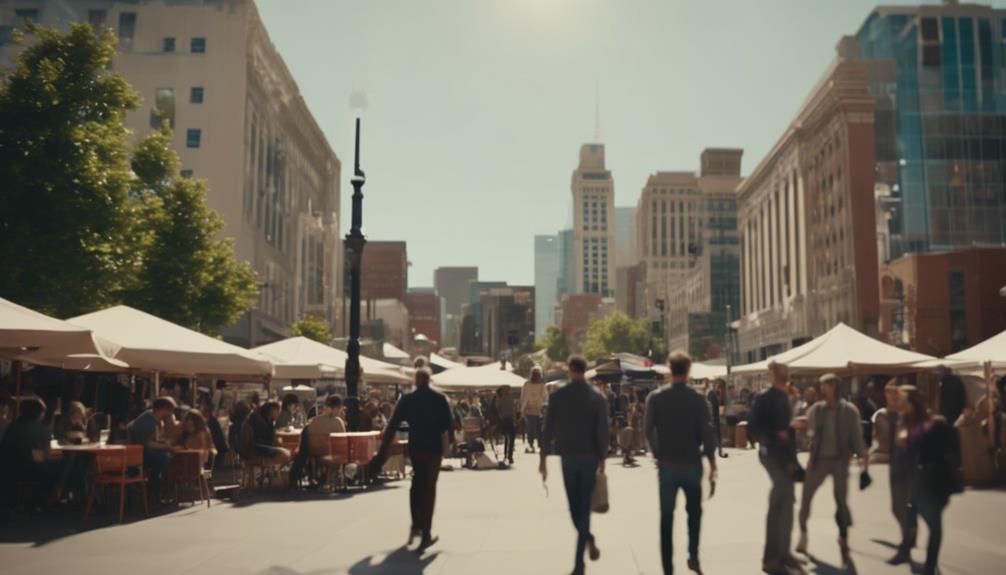
Investing in vibrant downtown public spaces drives significant economic growth by attracting visitors, increasing foot traffic, and stimulating local businesses. When you create engaging public spaces, you're fundamentally crafting economic engines that benefit the entire community. These areas become destinations, drawing people in and encouraging them to spend money locally.
For instance, successful public spaces like Bryant Park in New York generate millions in revenue annually through events, food kiosks, and sponsorships. This influx of money doesn't just stay within the park; it spills over into the surrounding areas, boosting local businesses and enhancing real estate values. Higher property values attract more investors, which in turn supports further real estate development and revitalization of downtown areas.
Consider the following economic benefits of vibrant downtown public spaces:
- Increased Foot Traffic: More visitors mean more potential customers for local businesses.
- Higher Real Estate Values: Attractive public spaces make nearby properties more desirable, driving up values.
- Economic Activity from Events: Hosting events generates substantial revenue through ticket sales, vendor fees, and sponsorships.
- Job Creation: New businesses and events create employment opportunities for the local community.
- Enhanced Retail Sales: Increased tourism and local spending boost retail sales, contributing to overall economic vitality.
Strategically investing in placemaking initiatives not only revives downtown areas but also sustains their economic health. You'll find that vibrant public spaces are magnets for residents and tourists alike, creating a bustling commercial environment that supports local businesses. By focusing on creating and maintaining these areas, you can secure a thriving, dynamic downtown that benefits everyone.
Cultural Activities
Cultural activities in public spaces, like free art exhibitions and performances, strategically draw diverse audiences and foster community engagement. When you walk through downtown areas such as Bryant Park, you're not just passing through a park; you're stepping into a hub of cultural vibrancy.
With over 1,000 cultural events annually, Bryant Park exemplifies how public spaces can become dynamic centers of activity, attracting a wide range of people.
Events like WaterFire in Providence, featuring over 80 bonfires on the river, illustrate the magnetic pull of cultural activities. These events don't just draw thousands of visitors; they also create a sense of shared experience and community. When thousands gather to witness the spectacle, they aren't just spectators but participants in a communal activity. This fosters community engagement, making people feel more connected to each other and the city.
From a strategic standpoint, offering free cultural activities in downtown areas enhances their appeal and accessibility. Public spaces become platforms for diverse cultural expressions, showcasing the rich tapestry of a city's artistic and cultural offerings. This not only enriches the cultural life of the city but also enhances social cohesion.
When people from different backgrounds come together to enjoy art and performances, it breaks down social barriers and builds a more inclusive community.
Frequently Asked Questions
What Is Vibrant Public Space?
Dynamic public spaces are bustling areas where community events, street art, pop-up shops, and buskers' performances thrive. You'll notice these spaces are always full of life and activity.
They strategically attract diverse groups through engaging activities and artistic displays. By fostering social interaction and economic opportunities, they create a sense of place and community pride, making them indispensable to downtown vibrancy and urban vitality.
What Makes a Public Space Attractive?
To make a public space attractive, focus on design aesthetics that are visually appealing and functional.
Prioritize community engagement by hosting cultural events that draw diverse crowds.
Implement safety measures to guarantee everyone feels secure.
Strategically include amenities like seating, greenery, and art installations.
Easy access via public transportation and parking is vital.
Why Is It Important to Create an Attractive Public Space in Big Cities?
Imagine a garden that blooms with economic benefits, community engagement, cultural expression, and social interaction. Creating an attractive public space in big cities isn't just about aesthetics; it's a strategic move.
You'll see economic benefits through increased visitor spending. Community engagement thrives as people gather. Cultural expression finds a stage, and social interaction flourishes.
It's about weaving these elements to foster a vibrant urban tapestry.
What Do Successful Public Spaces Do to Attract People?
Successful public spaces attract people by focusing on community engagement.
You can host cultural events that celebrate local traditions and feature street performers to create a lively atmosphere.
Incorporate interactive art installations that invite participation and curiosity.
Strategically, this mix of attractions guarantees that both residents and tourists find something appealing, fostering a sense of belonging and drawing in diverse crowds consistently.

